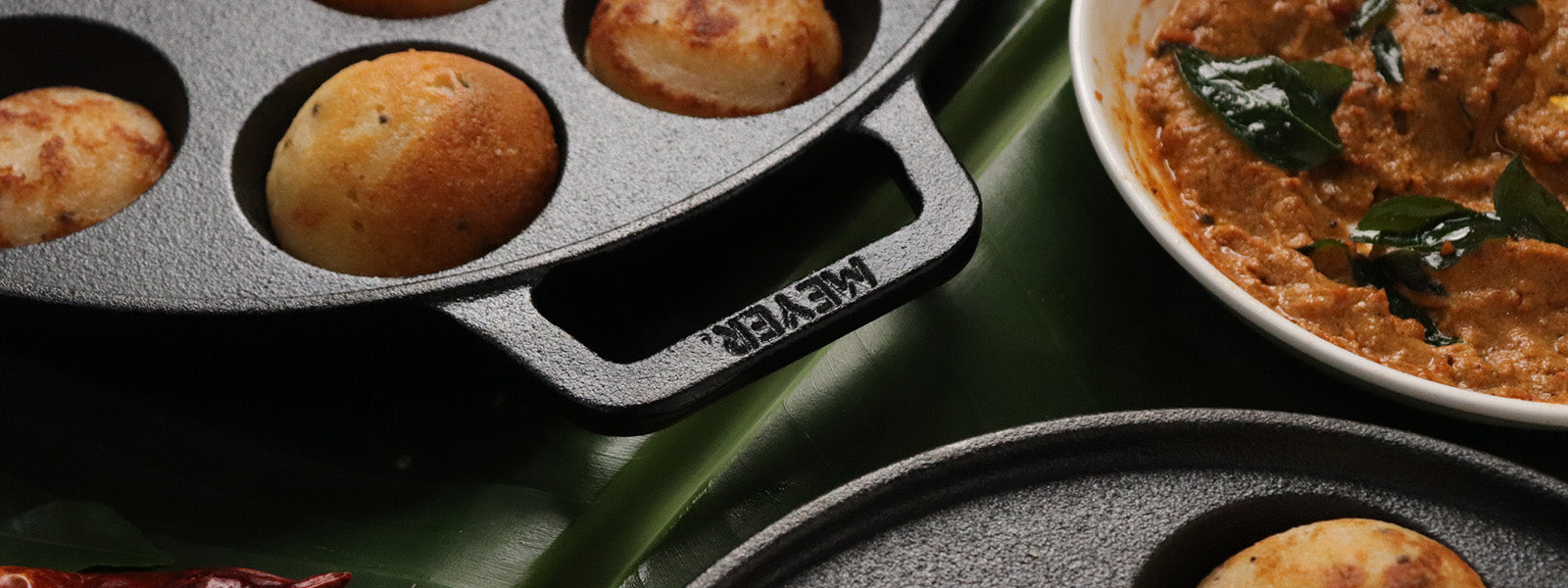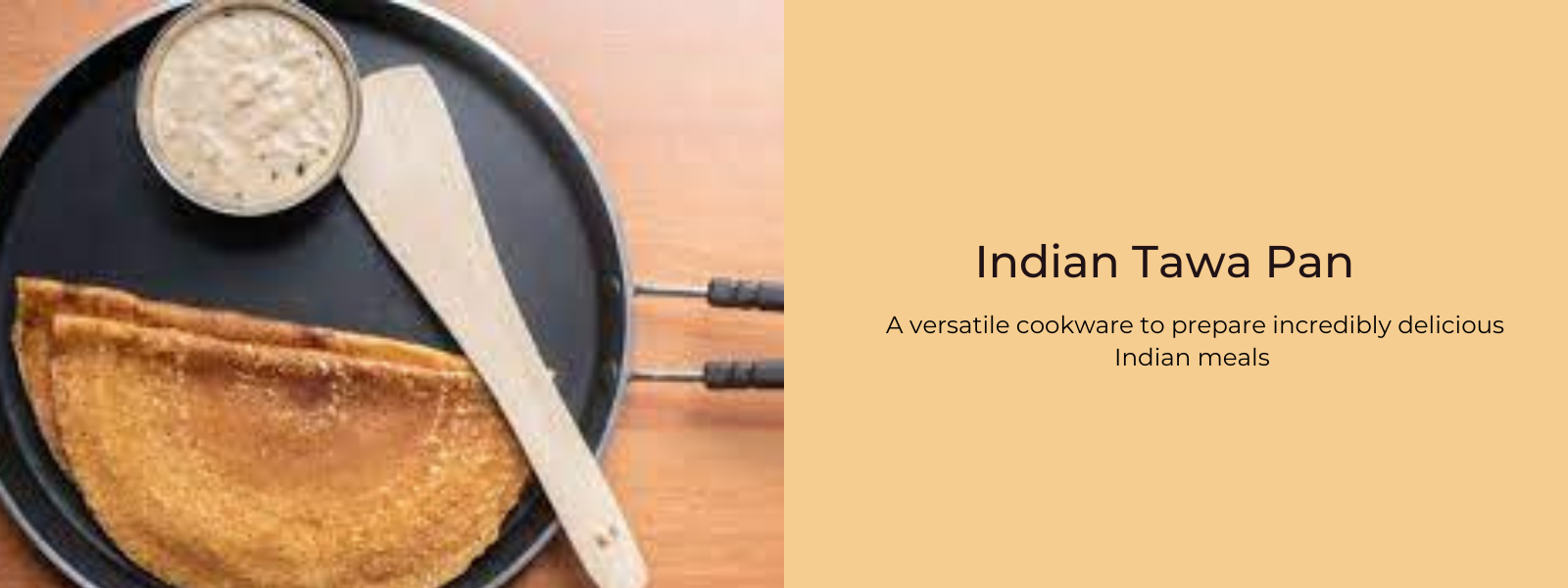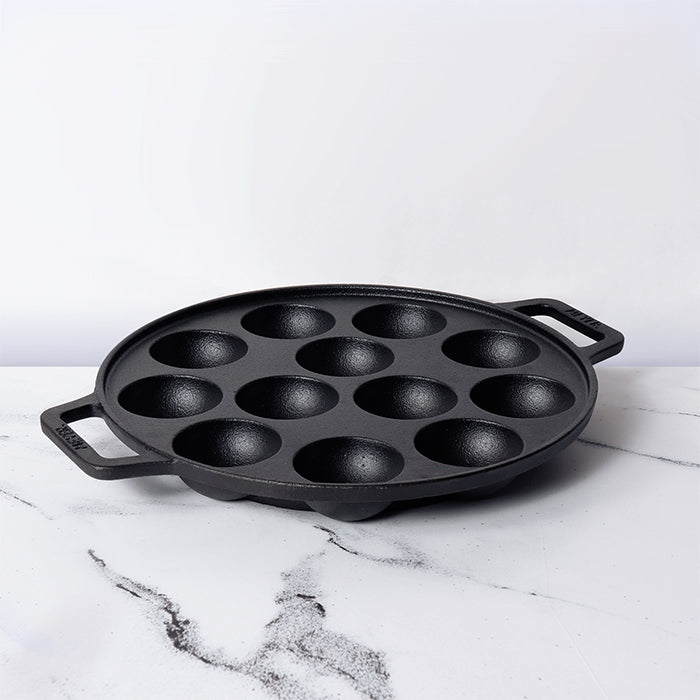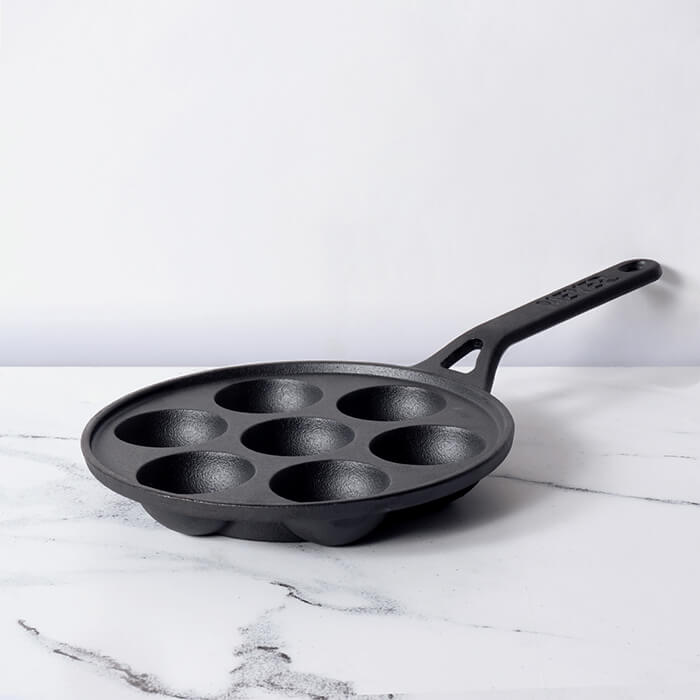An appe tawa, also called an appe pan or a paniyaram pan, is a special piece of cookware that is often used in South Indian cooking. It is a circular pan with numerous tiny, circular cavities or moulds. Typical appe tawa materials include cast iron, aluminium, and nonstick-coated metal.
The primary purpose of an appe tawa is to make a popular South Indian snack called appe or paniyaram. Appe are round, fluffy dumplings made from a fermented batter of rice and lentils or semolina. The batter is poured into the individual molds of the appe tawa and cooked until the dumplings are golden brown and cooked through.
The design of the appe tawa with multiple cavities allows for simultaneously making several appe at once. This makes it a convenient and efficient tool for preparing the snack. The cavities are shallow and rounded, giving the appe their characteristic shape.
An appe tawa can also be used to make other dishes such as vadas or bondas, depending on the specific recipe and ingredients used. It is commonly used on gas stoves, electric cooktops, or induction cooktops.
Different types of appe tawas are available in the market, including those made of cast iron, aluminum, or with non-stick coatings. The choice of material depends on personal preference, cooking style, and desired durability.
Overall, an appe tawa is a specialized cookware designed specifically for making appe or paniyaram, providing a convenient and efficient way to prepare this popular South Indian snack.
Table of Contents
Is Appe Tawa Different From Regular Tawa?
Yes, an appe tawa is different from a regular tawa. Here are the main differences:
Shape and Design: The most noticeable difference is in the shape and design of the tawa. A regular tawa typically has a flat and circular cooking surface, similar to a griddle or frying pan. In contrast, an appe tawa has multiple small, round molds or cavities on its surface. These molds are used to shape and cook the appe or paniyaram batter into round dumplings.
Purpose and Usage: A regular tawa is a versatile cooking tool used for various purposes, such as cooking rotis, parathas, dosas, pancakes, and other flatbreads or foods. It provides a flat cooking surface for these items. On the other hand, an appe tawa is specifically designed for making appe or paniyaram, a specific South Indian snack. It is used to cook the batter into round dumplings with a soft and fluffy texture.
Cooking Technique: The cooking technique used on a regular tawa differs from that used on an appe tawa. A regular tawa is often used for direct cooking, where the food items come into direct contact with the cooking surface. This allows for browning, searing, or frying. In contrast, an appe tawa is used for indirect cooking. The batter is poured into the molds, and the appe cook within the cavities, creating a rounded shape.
Size and Capacity: Regular tawas are available in diameters ranging from big to small to accommodate various cooking requirements. Appe tawas usually have diminutive heating surfaces with multiple moulds. The number of moulds can range from seven to twelve or more, based on the type of appe tawa.
It's important to note that while a regular tawa can be used for cooking a wide range of foods, an appe tawa is more specialized and primarily used for making appe or paniyaram. If you enjoy making appe or other similar snacks, investing in an appe tawa can be beneficial to achieve the specific shape and texture of the dish.
What Are The Uses Of Appe Tawa?
An appe tawa, also known as an appe pan or paniyaram pan, is a specialized cookware used primarily for making appe or paniyaram, a popular South Indian snack. The appe tawa serves several purposes:
Making Appe/Paniyaram: The main purpose of an appe tawa is to cook appe or paniyaram, which are round, fluffy dumplings made from a fermented batter of rice and lentils or semolina. The tawa's round molds or cavities are designed to shape the batter into small, round appe.
Efficient and Even Cooking: The design of the appe tawa with multiple molds allows for simultaneous cooking of several appe at once. This saves time and ensures even cooking throughout. The molds distribute heat evenly, resulting in consistent browning and cooking of the appe.
Unique Shape: The round molds on the appe tawa give the appe their distinctive shape. The cavities create a round, puffy appearance with a slightly crispy exterior and soft interior. The shape and texture are key elements of the appeal and taste of appe.
Versatility: While the primary use of an appe tawa is for making appe or paniyaram, it can also be used to make other similar dishes such as vadas or bondas. The round molds provide a convenient way to shape and cook these snacks.
Convenience and Portability: Appe tawas are compact and easy to handle, making them convenient for home cooking. They can be used on gas stoves, electric cooktops, or induction cooktops. Their small size also makes them portable and suitable for outdoor cooking or when traveling.
Non-Stick Options: Many appe tawas come with a non-stick coating, making it easier to remove the cooked appe without sticking. The non-stick surface reduces the need for excessive oil and makes cleaning the tawa easier.
Overall, an appe tawa is a specialized cookware specifically designed for making appe or paniyaram. Its purpose-built design, efficient cooking, and unique shape make it a handy tool for preparing this delicious South Indian snack.
Popular Appe Tawa Recipe:
One of the most popular and widely enjoyed appe or paniyaram recipes is the traditional "Kuzhi Paniyaram." Here's a how to make Kuzhi Paniyaram:
Ingredients:
- 1 cup idli or dosa batter (fermented rice and lentil batter)
- 1 small onion, finely chopped
- 1-2 green chilies, finely chopped
- 1/2 teaspoon ginger, grated
- Coriander leaves chopped, handful
- Salt to taste
- Oil for greasing the appe tawa
Instructions:
- Integrate batter of idli or dosa along with chopped onion, grated ginger, coriander leaves, green chilies, and salt in a mixing basin. Mix thoroughly to uniformly distribute the ingredients.
- Place the appe tawa on medium heat and grease each of the molds with a few drops of oil.
- Once the tawa is heated, pour a spoonful of batter into each mold, filling them about three-fourths full.
- Allow the paniyarams to cook on medium heat until the bottom side turns golden brown and crispy. Use a skewer or spoon to gently flip them over.
- Cook the other side until it becomes golden brown and cooked through. Ensure that the paniyarams are evenly cooked on all sides.
- Once cooked, remove the paniyarams from the tawa and repeat the process with the remaining batter.
- Serve the hot and crispy paniyarams with chutney, sambar, or a side of your choice.
Note: You can also add variations to the basic recipe by incorporating ingredients like grated coconut, chopped vegetables, or spices to suit your taste preferences.
Kuzhi Paniyaram is a versatile dish that can be enjoyed as a breakfast or snack item. Its fluffy texture and savory flavors make it a favorite among many South Indian households.
Best Appe Tawa in India:
Meyer Pre Seasoned Cast Iron 2 Sides Handle Appam Pan, 26cm is the best appe tawa for its incredible quality and durability.
Features:
- Appe Tawa without any toxin
- Unrivalled in terms of thermal retention
- Unadulterated iron ore material heats rapidly and retains heat for an extended period, conserving cooking gas.
- Heavy-gauge construction for increased thickness and sturdiness
- No chemical or synthetic coatings applied – simply seasoned with 100 percent vegetable oil; Over time, a simple seasoning technique creates a chemical-free non-stick surface.
- Perfectly round openings and cavities: Simple to prepare, caramelised and crisp Paniyarams, Bondas, Appam, Koftas and more
- Adds a rustic and authentic essence to your dish
- The pan has ergonomic dual handles for a secure hold and ease of handling
- Ideal for outdoor cooking and campfire; can withstand high-temperature cooking and direct flame contact.
- Oven-safe up to 260 degrees Celsius. Metal utensil secure











Leave a comment